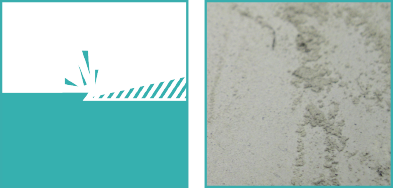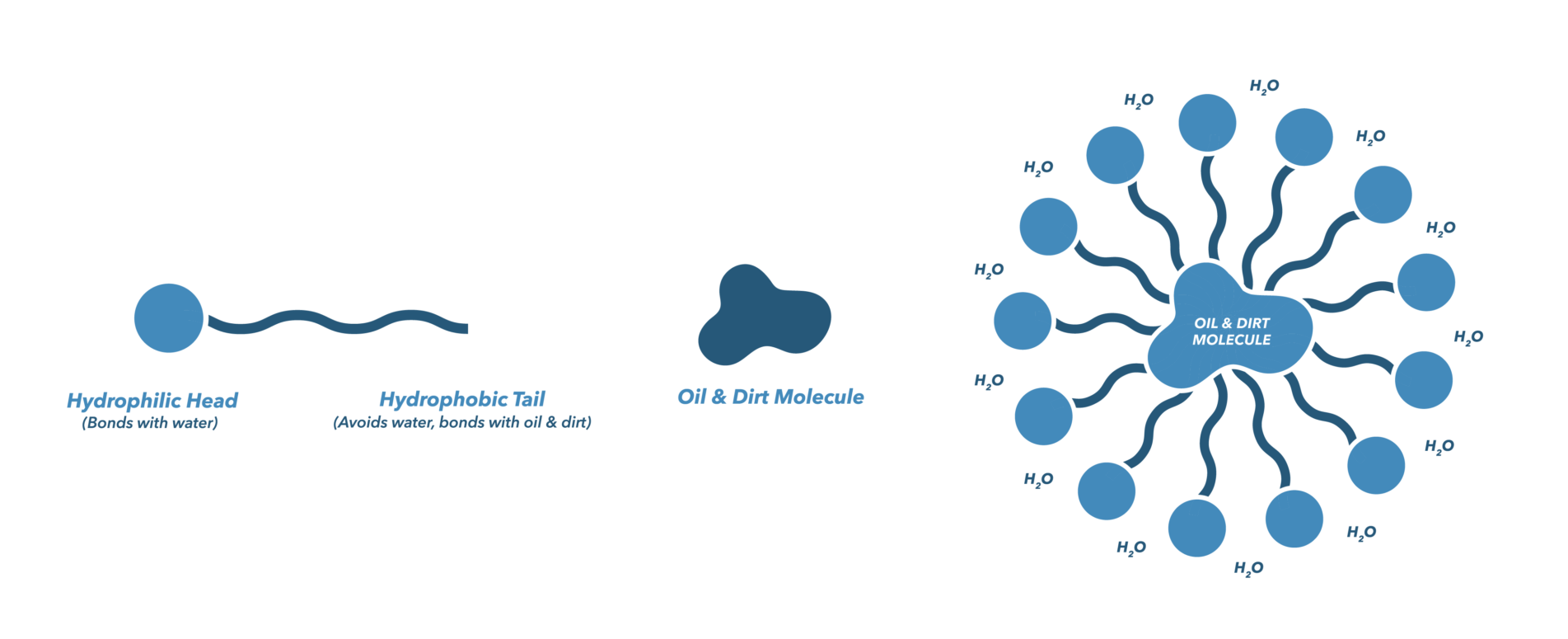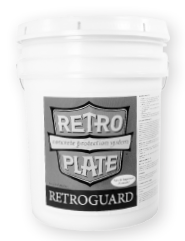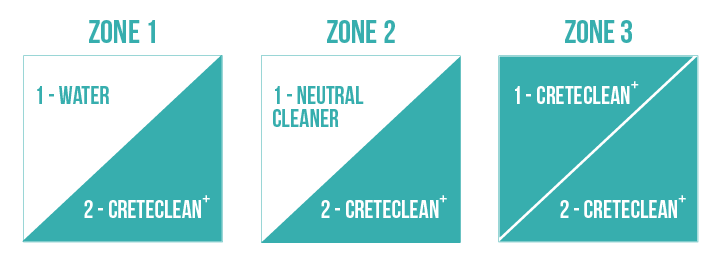.
Why Clean?

The better you care for your floor, the longer it will last, and the longer it lasts, the less it will cost.
.
Protecting Your Investment
Thousands of dollars and hours of manpower have gone into creating your floor. Imagine buying an expensive car, and never maintaining it properly – no changing the oil, no washing and waxing, no cleaning up the drink that got away when the car in front of you stopped short. Wouldn’t happen, right?
Your floor deserves, and requires, the same care. The good news is, properly caring for your floor won’t cost you an arm and a leg. In fact, the only thing that will is replacing what you already paid for. Having to repair or replace your floor entirely will be costly and time consuming; interrupting your business, productivity, and ultimately your bottom line.
Proper Maintenance Matters
Concrete floors are strong, functional, and long-wearing. However, they are not bullet proof. Nothing will reduce your concrete floor to a dull, dirty, lifeless surface faster than using the wrong cleaner. The wrong cleaner can actually attract dirt! It is even worse to assume your floors need no maintenance at all.
In addition to becoming dull and lifeless, using the wrong cleaner can lead to etching, staining, and accelerated erosion of the surface. First impressions matter, as do second, third, fourth, fifth, and so on.
What’s the return cost of proper maintenance versus poor maintenance? It’s the extension of the life of the floor versus the abbreviated life and added cost of reapplication due to improper or no maintenance at all.
.
Understanding Your Concrete Floors
Concrete is strong, but not invincible. Concrete floors are strong, functional, and long-wearing. However, they are not bullet proof. But knowledge is power. With a proper understanding of how concrete reacts and responds under certain conditions, you can keep your floors in excellent condition for many years – avoiding costly mistakes, and saving you and your business valuable time, money and resources. You’ll quickly realize that concrete is as tough as you think it is, but there are a few things to be mindful of.
Erosion + Wear
Non-densified concrete floors are subject to wear and tear. The friction caused by dirt, debris, foot and vehicle traffic all contribute to degrading your floor, leaving it vulnerable to abrasion, dinginess, etching, staining, scratching and chipping.

Porous
Concrete has a pore structure that is a magnet for solubilized dirt and soil. This causes your floor to have a dull appearance, eliminating the attractive sheen and light reflectivity it once had. These pores are also channels for oil and other liquids to infiltrate into the interior of the slab, causing discoloration and staining.

Reactive
All concrete floors, whether densified or non-densified, are naturally sensitive to acid. While concrete densification closes the majority of the pores in concrete, minimizing acid penetration, the concrete is still sensitive to acid etching and staining.

.
Not All Cleaners Are Created Equal
Not all floor cleaners are created equal, and this is especially true for concrete cleaners. Selecting a concrete cleaner specifically designed to complement and work with concrete floors is essential to keeping your floors in excellent working condition and looking amazing!
.
3 Concrete Cleaning Myths
When it comes to concrete cleaning, there are three myths that are as harmful to your floor as dirt and debris.
- MYTH 1: Concrete Floors are Maintenance Free
Concrete floors are durable, yes, but they are not immune to wearing. They require regular maintenance with the right cleaner. Using the wrong cleaner can literally attack and dull the desired appearance of your concrete floor. Concrete floors are not maintenance-free. Instead, they are low-maintenance.
- MYTH 2: Cleaning with Water is Good Enough
Using water only to clean concrete does little more than spread the contaminants around. The majority of the dirt, soil, grease and grime remain on the floor to continue degrading it.
- MYTH 3: Neutral pH Cleaners are Safe for Cleaning Concrete
Simply because a cleaner has a neutral pH does not mean it is necessarily safe for your floor. Many contain citric, caustic or acidic components that will do your floor more harm than good. An overly acidic or basic cleaner will etch concrete. So what is the proper pH level for a cleaner? It is in the 9-10 range, which is similar to cured/aged concrete.
- MYTH 1: Concrete Floors are Maintenance Free
Is Your Cleaner Safe for Concrete?
Your cleaner may be unsafe if it:
- Contains acids, hydroxides or sulfates
Concrete is sensitive to acid which can lead to etching and staining. Sulfides and hydroxides will eventually soften concrete.
- Has a pH level ABOVE or BELOW 9-10
A safe concrete cleaner is not neutral (7), but rather similar to the pH of cured/aged concrete (9-10). An overly acidic or basic cleaner can etch concrete.
- Contains acids, hydroxides or sulfates
Polar Micelle Technology
CreteClean Plus with Scar Guard™ utilizes Polar Micelle Technology. Soap molecules penetrate the floor surface and emulsify oil and dirt into smaller particles. The soap molecules then completely surround the oil or dirt molecule, creating a micelle. The micelle attaches itself to water molecules and is held in suspension, then carried away in the rinse water.

.
Testing
Comparison: CreteClean Plus vs. Water, Neutral Cleaner
At first thought, dirt is just dirt. And dirt on a floor is just dirty. But on a concrete floor, it is so much more than that. Dirt is one of the main contributing factors to a dull concrete floor. The soil and grit tracked in from the outside act as an abrasive medium, similar to that of 200-grit sandpaper, which scratches and effectively deteriorates the attractive sheen on your concrete floor.
Test Parameters: One continuous piece of polished concrete (which received little to no traffic and received periodic cleaning) divided into three zones. Cleaned using a brand new auto scrubber. Each zone cleaned twice with the proper amount of drying time in between. After each cleaning, the auto scrubber waste water was collected and bottled. The auto scrubber tank, pads, filter, etc. were thoroughly cleaned each time before switching to the next cleaning agent.
Test Results: Notice the significant amount of dirt collected when cleaned with CreteClean Plus – especially on the second cleaning after water and a neutral cleaner had already been used. In Zone 3, CreteClean Plus picked up almost all of the dirt and soil on the first cleaning, leaving barely any dirt and soil to be cleaned up on the second cleaning.

.
Cleaning Plan

Immediately
Clean spills immediately to avoid etching, staining and slip & fall hazards.
.
Daily
Sweep / Dust mop daily to limit dirt and soil build-up.
.
2-3 Times / Week
Mop or auto scrub the floor 2 to 3 times per week (or more often as necessary).
.
Every 6 Months / As Needed
Apply / Re-apply additional protection products and burnish the floor every 6 months (or as your facility requires).
.
Tips for Optimal Performance
Clean Exterior Entries
Sweeping exterior entries regularly will prevent dirt and soil from entering your facility, as will clearing ice, snow and salt during the winter season.
.
Walk-Off Matting/Grating
Reduce the amount of outside debris brought onto your floor with walk-off mats or grating at all entry points of your building. This will minimize the damage these particles can cause your floor.
.
Sweep / Dust Mop Regularly
For dirt and debris that do make its way onto your floor, frequent dust-mopping will reduce the abrasion and erosion they cause. Frequent dust-mopping will also make your floor much easier to clean.
.
Clean Spills Immediately
Clean spills immediately to avoid etching, staining and slip and fall hazards. It’s true that an ounce of protection is worth a pound of cure. Quickly cleaning up spills, especially acidic liquids, will prevent chemical attacks and reactions. When contaminants are allowed to dwell on the surface, they penetrate the concrete more deeply, creating the need for a more aggressive solution.
.
Burnishing
If a higher level of sheen is desired beyond that produced naturally by routine cleaning, periodic burnishing can help accelerate or increase the sheen of your concrete floor. The following procedure applies to densified concrete only.*
1. Ensure the concrete is at least 28 days old.
2. Use a high-speed propane burnisher equipped with an abrasive black stripping pad.
3. “Buff” the surface by working the machine up and back so as to create a higher level of sheen.
4. Repeat step Step 3 utilizing a red pad to increase the intensity of the sheen.
Propane driven models with an 1800-3500 RPM work best. A standard 175 RPM swing buffer will take more buffing to create the desired sheen. Propane burnishers have the weight of the motor, and therefore pressure, directly over the head of the machine, whereas, electrically driven swing burnishers do not have enough pressure, regardless of the equipment’s RPM.
*For densified-polished concrete, please contact your local Curecrete representative or contact Curecrete directly.
.
Enhanced Protection for Your Floor
Topical, semi-penetrating, and penetrating sealers are optional products used to provide additional protection for densified and densified-polished floors. These products act as a “working” or sacrificial surface layer, protecting the treated concrete beneath. They also provide stain resistance and water repellency. As traffic and friction from dirt and debris wear away these protections, it will be necessary to replace these sealers. Applying these additional protections is an economical way to preserve your concrete floor.
RetroPel™ More product info!
RetroPel is a stain repellent that has been specifically formulated for concrete and terrazzo floors. RetroPel resists oil and waterborne stains, and when used in conjunction with the Ashford Formula, RetroPlate, or other densified and polished concrete floors provide additional protection.

RetroGuard™ More product info!
RetroGuard is a modified acrylic sealer yielding high reflectivity. The topical coating is suitable for protecting concrete and natural or synthetic stone surfaces against oil and food staining. It is UV-stable, and therefore, applicable on both exterior as well as interior surfaces. RetroGuard is highly effective at preventing acid staining on all stone and concrete surfaces, even keeping acidic fumes from the surface to which it is applied.

.
Extend to a Lifetime Warranty

Curecrete is unique in the industry when it comes to helping you maintain your concrete floor. We don’t stop at giving you the absolute best densified or densified-polished floor in the world – we want to help you keep it in exceptional condition for life. When you use CreteClean Plus with Scar Guard* to clean and maintain your floor, your 10- or 20-Year Ashford Formula™ or RetroPlate® Warranty can be extended to a Lifetime Warranty.
That’s how much confidence we have in CreteClean Plus being the RIGHT cleaner for your floor!

